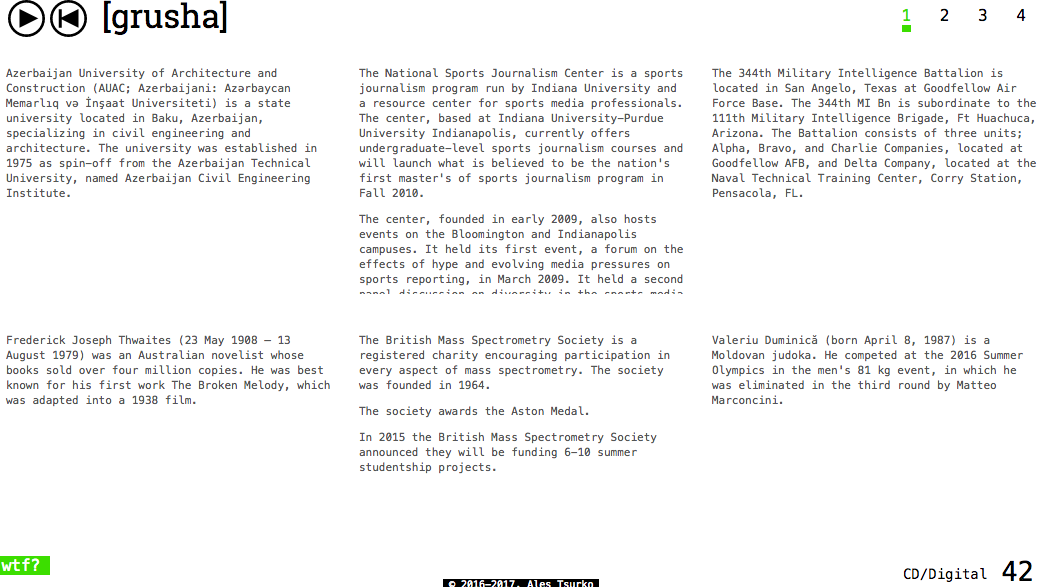Comments
microscale – generating music from random Wikipedia articles
Belarusian composer Ales Tsurko talks about how his new web-based album microscale uses regular expressions to generate music in real time from random Wikipedia articles, and how the album can be hacked to act as a sequencer for the listener's own music.

Ales Tsurko: microscale is a generative and web-based album. Although I’ve written generative/algorithmic music before, and almost all of my previous work has procedurally generated material, microscale is my first fully generative album which was created from a “generative” idea. At the same time, this album has been created not so much by thinking, as by emotions – so it’s not purely artificial intelligence or computer music. The web version can be found at alestsurko.by/microscale/.
How does it work?
The music on microscale is generated in real-time from random Wikipedia articles. Each article becomes a step sequencer, where the letters are the sequencer steps and the track titles are regular expressions that switch the steps of the sequencers on and off. For example, in the expression "[module]", it’s the letter “m”, “o”, “d”, “u”, “l” or “e”. When the sequencer position lands on any of these letters, it fires an event and plays a sound, and the letters become the “microscale” level of the meaning of the text.
The concept of the album is to show that through transforming one media (text) into another media (music), the meaning can be transformed – the article has its own meaning, but the music has a completely different meaning. And it’s not just one-to-one transformation – there are six articles (i.e. six meanings), which although unrelated to each other, create a whole piece of music that has one singular meaning. I like to see this metamorphosis in nature – something dies and disintegrates into parts, but then something new assembles from these parts.
Why did you choose the web page format to release microscale?
The web page is an artistic canvas that gives endless possibilities for an artist. Distributed and recorded music can not only be static now, but it can also continuously change before listener’s eyes. I’ve been carrying this idea for a long time, but there was no a good concept for something completed.
I also have another web-based project in collaboration with Belarusian composer Kanstantsin Yaskou (alestsurko.by/zona-opus-posth/). This was originally a cycle of piano pieces, so it should be considered as an interpretation or a “remix”, rather than a purely generative and web-based album.

While the letters are the microscale level of text meaning, I chose the title microscale because the music is created from this level. All the track titles are regular expressions.
[grusha] – Grushenka Tsiolkovskogo – the nickname of my ex-girlfriend on social media.
[random] – simply … random.
[module] – inspired by s i m u l a t i o n_ by Felix Rothschild (felixrothschild.de).
[beacon] – I imagined a picture of a beacon in the dark when I wrote this piece.
Apart from the web version, is microscale available in other formats?
Yes, there are three versions of the album – real-time (web-based), physical and digital.
The web version can be found at alestsurko.by/microscale/ and is generated in real-time on the screen right in front of you. And for programmers – the album is hackable! You can edit the regular expressions and you can also change the samples, tempo and other parameters in the scripts/songs-data.json file to your own. So, microscale can actually be used as an instrument – as a sequencer for your own music. I’ve made the source available at github.com/AlesTsurko/microscale.
For the physical version, I wrote a special program that generates the four individual album tracks and then burns a CDR. Each time the program is used, it generates the four tracks randomly, which means the music is slightly different each time the program is used and each CDR is totally unique and there are no identical versions of the physical album. The digital version is a one-time rendered version of the album – both are available on from Preserved Sound.
